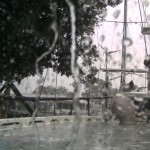Claude Desjardins arrived yesterday morning with a Torqeedo Cruise 4.0 and in a couple of hours we cobbled together a suitable bracket to mount it on. Its size is sufficiently different from the Epod to mean the well opening would have to be rebuilt to accommodate it. But for this test we easily manouvred it through the gap. At 18kg its about half the weight of the Epod and hey, you know how anal I am about weight, so this is definitely a plus.
Also on board were a motley assortment of characters from the boatyard and beyond. As well as the usual suspects, Steve and Sean, we also had some fellow electric boat afficionados in Tarci and two Bryans, and to ride shotgun for us, Claude’s son, Nicholas came along.
We pulled gently away from the dock and then ramped up the power to see what it would do at full throttle. We got her up to 5.3 knots with a little current (maybe half a knot) against us. This is more than I ever saw from the Epod (but mind you I had lost confidence and wasn’t game to give it full throttle for more than a moment when manouvring). And this 5.3 knots is with 8 people on board.
Coming back down soon after, we topped out at 6.5 knots. If we average these, we should expect top speed in still water to be 5.9 knots.
At maximum power it is using 4400 watts, or 90 amps from the batteries. At this power I could go for maybe two hours. But that extra few knots of speed costs a lot in power consumption. At a lower speed of 3.4 knots it only draws 900 watts, or 17 amps. And at this speed I could travel for over ten hours.
You should see the helm control for the Torqeedo – it has a great LCD readout showing speed, (it has its own GPS built in), power being used, battery state (such as voltage but you can choose from other options), and range left in the batteries at this speed.
For example, one of the readings showed power consumption as 500 watts, speed at 3.2 knots, and available range at this speed: 56 miles. So its a really useful tool to have right at your finger tips.
I compared this to the Link 10 battery monitor and we found an excellent correlation. At the end of the run the battery capacity remaining, as reported by the Torqeedo controller was 84%. According to the Link 10 we had used 32 amphours, which out of a total of 200, is 16% – which means 84% remaining.
In this test we went up the river and back to the boatyard, then kept going downriver to the shallows, then back up to Monty’s, and then a few loops before we docked. And used 32 amphours. When I first left Monty’s with the Epod, it used 50 amphours to get out of the river. This was all low speed work, and probably about half the distance we went in the Torqeedo. There are other variables of course but its clear that the Torqeedo is more efficient than the Epod – and maybe around twice as efficient. This effectively doubles my battery capacity.
We tried an emergency stop – that is we got her up to full speed of 5.3 knots and then put the motor into full power astern. This was perhaps the most disappointing aspect of the Torqeedo. At full astern its maximum power demand was 1300 watts, and the slowing effect could only be described as gentle. The specs on the Torqeedo show that is limited to 50% power in reverse, but we only saw about a 30%, and that’s how it felt too.
Compare this to the Epod which has full power available in reverse and that is useful for manouvring.
The Torqeedo unit is steerable. Even though we didn’t test this on the day, I can see how I could link it to the spectra steering lines so that the motor would steer with the rudder and that would be great for close quarters manouvring.
I have some detailed figures of power and speed and if you want to see them, let me know.
I’m leaning strongly to the Torqeedo, but I’m choking on having to throw away the $8000 I’ve spent so far on the Epod. The Torqeedo is very well engineered and I’d have confidence that it would work when I need it (well, what else would you expect, after all, it is German). And that’s probably going to be the deciding factor, because even though I can see how to fix the Epod in such a way that it would be reliable, I’ve just about had a enough of it.
And hey, its arguably now the best engineered Epod available, so perhaps someone will buy it from me…


